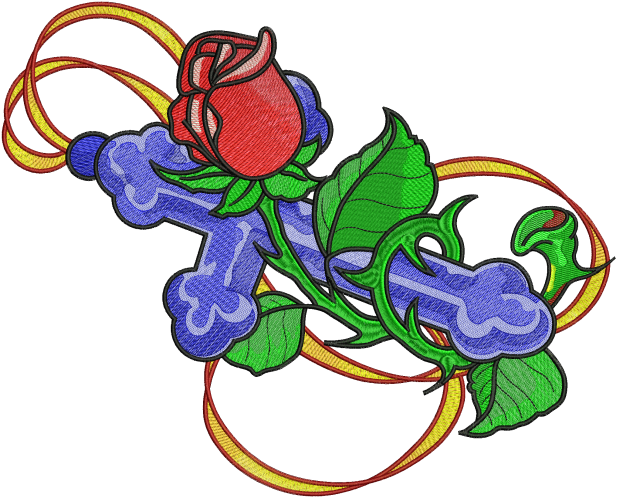I just had one of those embroiderer and 'can't make up her mind' customer interactions.
The antagonist of the story, played by the customer, is a great water color painter -- if you don't believe her, just ask her -- and, she brings in 3 water color paintings. Well, I couldn't tell if two were water color paintings, or an attempt to use EVERY color in her Brookstone's, Bob Ross Paint-by-Color set that she received for Mother's Day.
These paintings would have made Claude Monet wish he were a house painter, or maybe a matador! However, one of them did catch my eye, and I thought to myself, "wow, she really can paint." And, at just the moment I'm thinking that, she tells me, "these two are mine, the one you like was my inspiration, and, painted by my sister-in-law. THE LIGHT BULB WENT OFF! Her sister-in-law's painting used a few, but effective colors. They were neatly blended into a beautiful, impressionistic resemblence of the exterior of a gardener's shed. It was so well done, you could almost smell the potting soil and the musty wood floor. In an interview late in his life, Monet even mentioned the few colors he used in his paintings, "I use white lead, cadmium yellow, vermilion, madder, cobalt blue, chrome green. That's all." All that inspiring art in just FIVE COLORS!! You kidding me??!!
Back to our story .. Ms. Color-icious wants me to digitize the art that SHE created so it can be embroidered on organza and framed. Her idea is to paint someone's house and landscape and have it embroidered and framed. Then she is going to sell it to them. My reply was, "what a great idea, now, tell me, what are we going to do about all these colors?" She asked, "Oh, what do you mean?" Now, my life flashed back to my time at the University of Florida when I registered for an Art Appreciation class. I can distinctly remember asking myself WHY would I EVER have any reason for taking this class other than the fact that I needed one last elective. Alas, THIS was the time it came in handy, and, I was ready to seize the moment .. Carpe Diem, O Captain, My Captain. I went on for 10 minutes about the age of minimalism and the transition from realism to impressionism and the difference between Monet and Manet .. yes, there was a difference, and not just one letter. However, just when I thought I had her understanding me, she went on to a dissertation about the artist's eye, and the artist see's this, and the artist expresses that, and the artist has the hand, and the artist and the artist .. and the artist ..
.. and the artist ..
So, I cut to the chase. The cost of her wishes. Well, the look on her face when I told her the digitizing fee, the actual embroidery fee and that my machine ONLY holds 15 colors, and, if she wanted me to manually change the threads during the run the price increased by X .. her look brought me back to a more simple time, a more innocent time ..
.. all I can tell you is her look was the same look as my mom gave me when I told her that we super-glued Richie Cotrels head to the garage door to see if he could hang there like the man on the Super Glue commercial.
Hey, we were 10 years old .. stop laughing, his hair grew back .. though, I believe his DNA became an eternal part of that garage door on Dravis Avenue in Girard, Ohio. Oh, we would look at it and laugh later in life .. it acted as a gentle reminder of how lucky we were not to kill each other with our hair-brained ideas.
Further drifting from the purpose of this blog .. another part of that story just came back to me .. it's 1993, my 10 year high-school reunion, and Eddie Sprovorio brings out a recipe card sized hunk of white paint and wood 'taken' from THE garage door .. and, there was still hair in it!! When he was able to liberate that from the garage door, no one knows, and didn't ask .. but, what a story. You can't make this stuff up!!
So, getting back to the point of this blog .. so easily side-tracked, we are!
Just as good art is minimalistic and impressionistic in it's presentation, so is good embroidery. The more colors you add, the more confusion you add to your embroidery. Here is a good example. When I create leaves, if there is room for 2 colors, I only use 2 colors .. but, I change the stitch direction on both sides of the leaf so I give it some direction and the light catches the thread at different angles creating the look and feel of more than just one or two colors. Stitch direction, stitch length and how it reacts to the light can highly influence the look and feel of the design. The second color of the leaf is used for highlights. The second color is usually in the same color family of the leaf, just a bit lighter. I use the same technique when it comes to flower petals, as well.
Look at the embroidery below. Notice how gentle the secondary color is added. Notice the stitch direction changes and the subtle highlights. If you use the "less-is-more" philosophy, you can create beautiful embroidery very easily. Many reds can be reduced to ONE or TWO reds, and the same goes for any design with a plethora of colors.
Hope you enjoyed reading this as much as I did writing it ..
Best regards,
Rick Macali / 407 509-2400
www.inhousedigitizing.com
www.embdesignsnow.com
